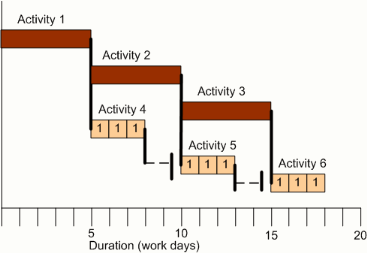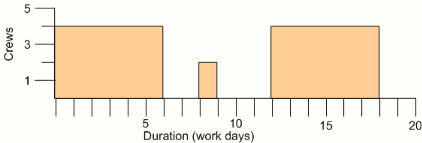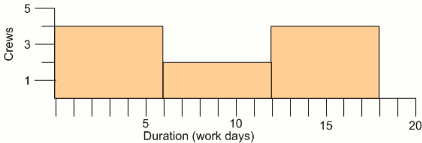unlimited resource leveling
Unlike the limited resource allocation problem, the unlimited resource leveling assumes that there are sufficient resources available to complete all tasks. Since there are sufficient resources, the project duration may not be moved during the unlimited resource leveling process. The goal of the unlimited resource leveling algorithm is to achieve the lowest labor costs, while completing the project on-time.
The two resource techniques are, however, similar in one critical way. Schedulers cannot rely solely on computer software to provide solutions. The judgment and experience of the scheduler are critical to both resource methods.
To start our discussion of resource leveling, consider the six activity schedule below.

histograms
The “resource histogram” is the most important tool used during resource leveling. Each bar on the histogram counts the number of resources, typically crews or workers, needed for that day. To create the resource histogram, begin with a fenced bar chart. The bar chart below has six activities, three of which are the subject of our analysis. Note that the activities on the fenced bar chart are shown in their “early start” position.
The resource histogram shows that the one crew is required to be on site for three working days, followed by a gap of two work days. The question for you to consider is what does the crew do for the two days of the gap?

If there are other jobs nearby, then the crew could move to those jobs for the two day gap. Often, however, what will occur is that the crew’s productivity will decrease to allow them to complete their work following the completion of the prior activity. For our small example this will increase the total crew days from nine actual work days to twelve total days. This decrease in productivity results in a forty percent increase in labor costs. The interesting aspect of this problem is that an inexperienced project manager will see everyone being busy and apparently productive. At the end of the job, they will wonder how they lost money when everything was going along so well.
The schedule below shows how not considering resource levels during a project may result in quality control problems. Notice that the crew of interest arrives on the site and completes the majority of their work with only a two day gap. The final activity, however, occurs at the end of the job. The crews completing these tasks will often want to try to complete the work out of sequence so that they will not have to return to the project.

Workers trying to self-optimize their efforts will often act in ways that cause problems for the overall project. Completing work out of sequence typically, however, results in tear-out and rework as prior work must be accomplished, and then the incorrectly sequenced work must be repaired. Anticipating these difficulties is the job of an experienced project manager, some of the difficulties may be identified in advance if a critical evaluation of resource levels is conducted.
Here are three histograms. What kind of worker behavior might be expected in these situations? What might you do to correct these difficulties.



reduce crew churn
One way to think of resource leveling decisions, particularly on big projects, is that differences in the levels of crews during the project would, if followed without reconsideration, result in the firing and rehiring of workers many times during the project. This “churn” in resources would result in (1) increased labor costs as workers require more enticement to work on short-term projects, (2) decrease in productivity as different workers familiarize themselves with the jobsite and working conditions, and (3) decreases in quality as the dynamic workforce must be retrained on the quality specifications required on the project.

what can be done?
Here are some of the steps that project managers take to resolve inconsistent resource requirements during a project.
| Technique | Possible Result |
|---|---|
| Delay activity start | may eliminate gap between repetitive tasks |
| Reduce crew size | decreasing productivity may reduce gaps |
| Overtime use | short term productivity increase, decrease high volume activity |
| Change methods | different equipment and/or methods, may increase productivity |
| Subcontracting | outsourcing to gain additional resources, in the case of good local resource market |